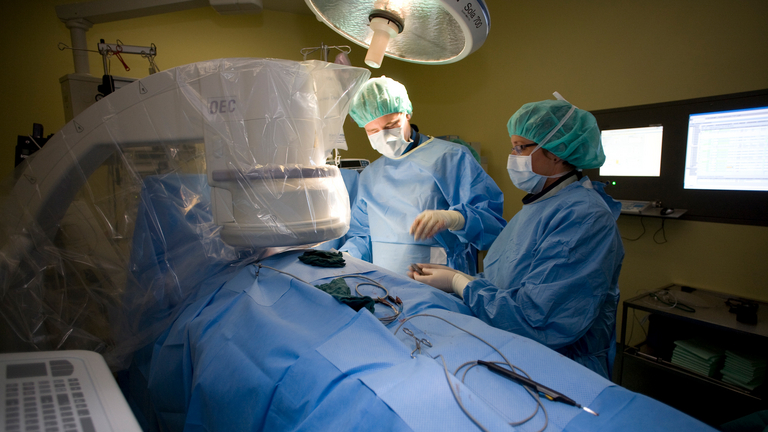
Arrhythmia surgery
Atrial fibrillation is a type of cardiac arrhythmia that increases a patient's risk of stroke. Specific measures will therefore need to be taken prior to and following heart surgery, with a number of different options available in this regard.
Contact
Cardiac arrhythmias - treatment approach in patients undergoing heart surgery
Atrial fibrillation is a type of arrhythmia that can be extremely uncomfortable for the patient. It requires careful planning prior to surgery and during the surgical procedure itself, as well as with regard to treatment following surgery.
Patients with atrial fibrillation are at an increased risk of stroke as a result of blood clots forming inside the left atrium, which can then travel from the heart to other parts of the body, including the brain. Patients therefore require long-term treatment with anticoagulants, which in most cases will involve the use of Falithrom™ or Marcumar™ [phenprocoumon].
Patients who undergo heart valve surgery usually do not require anticoagulation therapy if treatment involves a bioprosthetic (tissue) valve. However, as this only applies to patients with normal sinus rhythm, patients with atrial fibrillation will require long-term anticoagulation therapy even if they receive a tissue valve.
In spite of the fact that Falithrom™ [phenprocoumon] treatment has been optimized by means of self-monitoring and self-testing, patients taking Falithrom™ may develop complications as they get older. These complications may be the result of overdosing/underdosing or an increasingly fragile constitution, and may result in an increased risk of stroke.
Treatment aimed at eliminating atrial fibrillation and restoring a normal sinus rhythm would therefore appear advisable in order to avoid the need for long-term anticoagulation therapy.
Today, atrial fibrillation can be permanently eliminated using either catheter-based interventions or conventional surgery. Details on catheter-based interventions can be found in a separate section on this website.
Nowadays, catheter ablation of atrial fibrillation can be combined with other scheduled surgical procedures, such as those involving either the heart valves or coronary arteries. As part of this procedure, specialist catheters are used to apply heat (radiofrequency energy) to specific sites within the left atrium. This process creates scars, which permanently prevent electrical impulses from entering the circular pattern responsible for atrial fibrillation, resulting in impulse propagation along only the normal electrical pathways. This procedure can permanently eliminate atrial fibrillation in 80% of patients with paroxysmal (occasional) symptoms, and in 20-50% of patients with chronic (persistent) symptoms. Not only are there no problems associated with combining this procedure with other scheduled heart surgery procedures, but the procedure itself carries a very low risk, and impacts only marginally on the overall length of surgery. As a result, it is suitable for use in the vast majority of cases.
An in-depth consultation between the surgeon and the patient is essential in order to discuss specific details in relation to a particular case. For instance, the use of catheter ablation is not advised in the treatment of patients with atrial fibrillation if there are additional reasons for why anticoagulation therapy must be continued (e.g. left ventricular dysfunction). Furthermore, it should be noted that approximately a quarter of patients undergoing catheter ablation for atrial fibrillation will require a pacemaker to be fitted after the procedure. If the procedure results in a normal sinus rhythm, it can be termed a success, as the patient has the additional benefit of no longer requiring anticoagulation therapy. However, if atrial fibrillation is not eliminated, the disadvantages will outweigh any potential advantages, as the patient will continue to require anticoagulation therapy, as well as having to attend their hospital or their local cardiologist for regular check-ups for their newly-fitted pacemaker. In addition, the pacemaker's battery will need to be replaced after a certain length of time.
Instruments used as part of catheter ablation procedures for atrial fibrillation (endocardial and epicardial approaches). Cooled bipolar radiofrequency ablation. An ablation clamp (bottom left) is used for catheter ablation performed as part of procedures that do not require the left atrium to be surgically opened (bypass surgery, aortic valve surgery). An ablation pen (middle) is used for catheter ablation performed as part of procedures that require the left atrium to be surgically opened (procedures involving the mitral valve or two heart valves).
